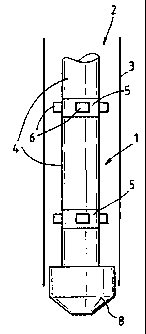Some of the information on this Web page has been provided by external sources. The Government of Canada is not responsible for the accuracy, reliability or currency of the information supplied by external sources. Users wishing to rely upon this information should consult directly with the source of the information. Content provided by external sources is not subject to official languages, privacy and accessibility requirements.
Any discrepancies in the text and image of the Claims and Abstract are due to differing posting times. Text of the Claims and Abstract are posted:
| (12) Patent: | (11) CA 2360192 |
|---|---|
| (54) English Title: | A PIPE ASSEMBLY AND LUBRICATING METHOD |
| (54) French Title: | TUYAUTERIE ET METHODE DE LUBRIFICATION |
| Status: | Term Expired - Post Grant Beyond Limit |
| (51) International Patent Classification (IPC): |
|
|---|---|
| (72) Inventors : |
|
| (73) Owners : |
|
| (71) Applicants : |
|
| (74) Agent: | MARKS & CLERK |
| (74) Associate agent: | |
| (45) Issued: | 2008-06-10 |
| (86) PCT Filing Date: | 2000-01-07 |
| (87) Open to Public Inspection: | 2000-07-20 |
| Examination requested: | 2002-10-29 |
| Availability of licence: | N/A |
| Dedicated to the Public: | N/A |
| (25) Language of filing: | English |
| Patent Cooperation Treaty (PCT): | Yes |
|---|---|
| (86) PCT Filing Number: | PCT/GB2000/000029 |
| (87) International Publication Number: | WO 2000041487 |
| (85) National Entry: | 2001-07-10 |
| (30) Application Priority Data: | ||||||
|---|---|---|---|---|---|---|
|
A pipe assembly (5) for use in a wellbore (3) having a plurality of outlets
(6) positioned
about the periphery of the pipe at longitudinally spaced apart intervals for
allowing fluid to
pass from the interior to the exterior of the pipe.
Cette invention a trait à une tuyauterie (5), utilisable dans un forage (3), possédant plusieurs orifices de sortie (6) disposés, sur sa périphérie, à intervalle les uns des autres, sur le plan longitudinal, cet agencement permettant à un fluide de passer de l'intérieur vers l'extérieur de la tuyauterie.
Note: Claims are shown in the official language in which they were submitted.
Note: Descriptions are shown in the official language in which they were submitted.

2024-08-01:As part of the Next Generation Patents (NGP) transition, the Canadian Patents Database (CPD) now contains a more detailed Event History, which replicates the Event Log of our new back-office solution.
Please note that "Inactive:" events refers to events no longer in use in our new back-office solution.
For a clearer understanding of the status of the application/patent presented on this page, the site Disclaimer , as well as the definitions for Patent , Event History , Maintenance Fee and Payment History should be consulted.
| Description | Date |
|---|---|
| Inactive: Expired (new Act pat) | 2020-01-07 |
| Common Representative Appointed | 2019-10-30 |
| Common Representative Appointed | 2019-10-30 |
| Letter Sent | 2015-01-08 |
| Inactive: Payment - Insufficient fee | 2011-12-29 |
| Grant by Issuance | 2008-06-10 |
| Inactive: Cover page published | 2008-06-09 |
| Pre-grant | 2008-03-20 |
| Inactive: Final fee received | 2008-03-20 |
| Notice of Allowance is Issued | 2007-12-10 |
| Letter Sent | 2007-12-10 |
| Notice of Allowance is Issued | 2007-12-10 |
| Inactive: Approved for allowance (AFA) | 2007-11-28 |
| Inactive: Adhoc Request Documented | 2007-10-23 |
| Inactive: Delete abandonment | 2007-10-23 |
| Inactive: Abandoned - No reply to s.30(2) Rules requisition | 2007-07-30 |
| Amendment Received - Voluntary Amendment | 2007-07-27 |
| Inactive: S.30(2) Rules - Examiner requisition | 2007-01-29 |
| Amendment Received - Voluntary Amendment | 2006-06-15 |
| Inactive: IPC from MCD | 2006-03-12 |
| Inactive: S.30(2) Rules - Examiner requisition | 2005-12-19 |
| Amendment Received - Voluntary Amendment | 2005-09-23 |
| Inactive: S.30(2) Rules - Examiner requisition | 2005-04-05 |
| Letter Sent | 2002-12-05 |
| Request for Examination Received | 2002-10-29 |
| Request for Examination Requirements Determined Compliant | 2002-10-29 |
| All Requirements for Examination Determined Compliant | 2002-10-29 |
| Letter Sent | 2002-07-03 |
| Letter Sent | 2002-07-03 |
| Inactive: Single transfer | 2002-05-10 |
| Inactive: Office letter | 2002-03-05 |
| Inactive: Cover page published | 2001-12-10 |
| Inactive: Filing certificate correction | 2001-12-03 |
| Filing Requirements Determined Compliant | 2001-12-03 |
| Inactive: Courtesy letter - Evidence | 2001-11-27 |
| Inactive: Notice - National entry - No RFE | 2001-11-19 |
| Inactive: First IPC assigned | 2001-11-19 |
| Application Received - PCT | 2001-11-08 |
| Application Published (Open to Public Inspection) | 2000-07-20 |
There is no abandonment history.
The last payment was received on 2007-12-17
Note : If the full payment has not been received on or before the date indicated, a further fee may be required which may be one of the following
Please refer to the CIPO Patent Fees web page to see all current fee amounts.
Note: Records showing the ownership history in alphabetical order.
| Current Owners on Record |
|---|
| WEATHERFORD TECHNOLOGY HOLDINGS, LLC |
| Past Owners on Record |
|---|
| GEOFFREY NEIL MURRAY |